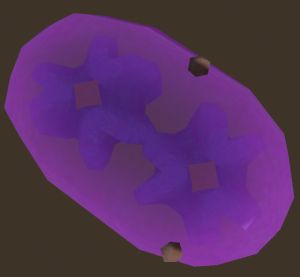Ferroplast
Uses Iron ![]() to produce ATP
to produce ATP ![]() by the process of Iron Oxidation.
by the process of Iron Oxidation.
A Ferroplast is a double-membraned structure containing a network of proteins and enzymes. It is a prokaryote that has been assimilated for use by its eukaryotic host. It works at a much higher efficiency than can be achieved with Rusticyanin.
Requirements
A cell must have a Nucleus to evolve Ferroplasts.
If organelle upgrades are enabled in game settings, the following condition must be true for the player cell:
- Contains Rusticyanin for at least 6 generations in a row.
Processes
Iron Oxidation: Iron ![]() → ATP
→ ATP ![]()
A method of generating energy without Glucose ![]() . Consumes Iron
. Consumes Iron ![]() .
.
Modifications
No modifications.
Effects
No effects.
Upgrades
No upgrades.
Strategy
In environments with plentiful Iron ![]() , Ferroplasts are excellent primary or secondary energy sources. In many patches, Iron
, Ferroplasts are excellent primary or secondary energy sources. In many patches, Iron ![]() can be found much more consistently than Glucose
can be found much more consistently than Glucose ![]() as large chunks of Iron
as large chunks of Iron ![]() ore can remain near the cell indefinitely. Be aware though that concentrations of Iron
ore can remain near the cell indefinitely. Be aware though that concentrations of Iron ![]() can decrease as the game progresses, so we recommend making use of additional energy sources before your cell starts to struggle.
can decrease as the game progresses, so we recommend making use of additional energy sources before your cell starts to struggle.
We also recommend replacing any pairs of Rusticyanin with Ferroplasts after evolving a Nucleus for far greater efficiency.
Scientific Background
Ferroplasts have not been discovered in real life, but are theorised to be entirely possible, based on the evolution of endosymbiotes (such as the Mitochondrion) and the energy-yielding capabilities of Rusticyanin. The actions of Rusticyanin at the cell membrane taking place at the organelle's membrane instead.
